Wolverton and Stony Stratford Tramway
History
The Wolverton & Stony Stratford Tramway was something of a peculiarity, being built primarily to transport workers between Stony Stratford and the large 'London North Western Railway'-owned carriage works at Wolverton. Its traffic was therefore largely confined to specific times of the day, during which it had to carry huge numbers of people, something it achieved by using the largest trailers ever to see the light of day in the British Isles. At the beginning and end of factory shifts, these were often coupled together as a rake of two or even three trailers, with an official capacity of 250, though probably carrying nearer 300, something which would have caused apoplexy amongst authorities elsewhere in the country, but which seems not to have been an issue in rural Buckinghamshire. Unfortunately, the company agreed to carry the workers for a fare of one shilling per week, which was far too low to be economically viable, with results that were all too predictable.
The tramway, which was built to a gauge of 3ft 6ins and was steam hauled, opened on the 27th May 1887. It was owned and operated by the Wolverton and Stony Stratford District Light Railways Company, which was in fact the third company to attempt to get the line off the ground, and was the brainchild of the tramway's contractor, Charles Hebert Wilkinson.
As built (under powers acquired in 1883 and 1884), the line extended to circa 2.75 miles, running from the L&NWR's Wolverton Station, westwards along New Wolverton Rd and Wolverton Rd to the Foresters Arms in Stony Stratford, where it turned northwestwards along the High St to a terminus outside the Barlow Mow. Wilkinson rather unwisely acquired further powers in 1887 to extend the tramway, the new line, which is believed to have been opened in 1888, continuing northwestwards from the Barley Mow, before turning southwestwards along Deanshanger Rd to a terminus at the Fox and Hounds in Deanshanger; this took the tramway to its maximum size, 4.72 miles. The extension was however ill-conceived, being predicated on freight traffic that subsequently failed to materialise.
The wasted investment in the extension came on top of a poor choice of tramway engines — from Krauss of Germany — which had proven to be hopelessly under-powered for the task of hauling one of the massive 100-seat trailers, let alone a pair, a situation which had necessitated the purchase of two additional engines from Thomas Green & Sons, an outlay that was presumably neither planned nor budgeted. Unsurprisingly, and within two years, the company was in serious financial difficulties, being unable to service either its creditor or its shareholder obligations.
In an attempt to save the company, it was reconstructed as the Wolverton and Stony Stratford Tramroads Company Ltd on the 26th July 1889, though seemingly without the buy-in of several key creditors, who took action to stop the reconstruction and force it into compulsory liquidation, the Receiver closing the line on the 17th December 1889. It remained closed for almost two years, before being re-opened on the 20th November 1891 by a local syndicate of benefactors, though in shortened form, from the Barley Mow to Wolverton. A new company — the Wolverton and Stony Stratford and District New Tramway Co Ltd — was eventually formed to take over from the benefactors, which it did on the 15th September 1893.
After a period of stability that lasted almost twenty years, motorbus competition reared its head in 1914, though the Great War, with its fuel rationing and bus requisition was to prove an unlikely savour in that regard. Unfortunately, its many other exigencies brought the company to its knees, and it entered voluntary liquidation on 17th July 1919. Salvation came in the form of the L&NWR, who no doubt viewed the W&SST as an anachronistic but necessary evil, which was needed to transport its workforce.
The L&NWR was amalgamated with numerous other railway companies on the 1st January 1923 to form the London, Midland and Scottish Railway Company, though this mattered little, as unfettered motor bus competition was resulting in sizeable annual losses. The last tram ran on the 3rd May 1926, the following day being the first day of the country-wide General Strike; when the strike finally finished, the LMSR simply chose not to re-open the tramway.
Uniforms
Throughout its 39-year existence, steam tram drivers wore railway footplate-like attire, heavy-duty or cotton jackets and a variety of headgear (bowlers, soft-topped caps and flat caps); no insignia was carried on either jackets or caps.
Prior to passing into the hands of the London and North Western Railway Company in 1920, conductors appear to have worn informal attire such as jackets, shirts and ties; headgear initially took the form of soft-topped caps, but in later years, the flat cap appears to have been the norm. An exception to this was a conductor named 'Little Billy' Newton, who wore a double-breasted uniform jacket and a military-style cap with a tensioned crown (top); neither jacket nor cap appears to have borne insignia of any kind. Why only this individual wore a uniform is unknown, though he was apparently a 'character', so it is entirely possible that it was self-purchased.
Photos of conductors taken after the railway company take-over have unfortunately not survived, so it is currently unclear if either the LNWR, or its successor the LMS, issued conductors with uniforms.
Given the nature of its operation, the company probably did not employ inspectors, and certainly, none of the numerous surviving photos show them. The available evidence also suggests that unlike the vast majority of UK tramway systems, the W&SST did not employ the services of women during the Great War.
Further reading
For a history of the system, see: 'The Wolverton and Stony Stratford Steam Trams' by Frank D Simpson; The Omnibus Society Publications Department (1981).
Images
Drivers and conductors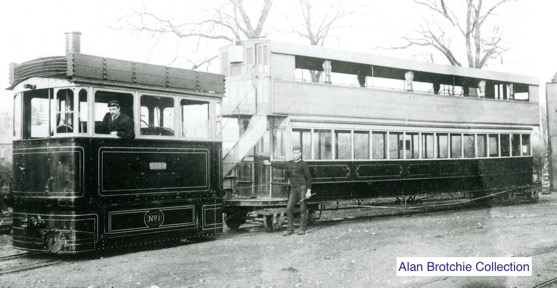
Steam Tram No 1 (a Thomas Green & Sons product of 1887) stands in the depot yard at Stoney Stratford. Although the photo is undated, the fact that the engine is in very good condition and the trailer is unencumbered by advertisements, strongly suggests that it was taken in the late 1880s.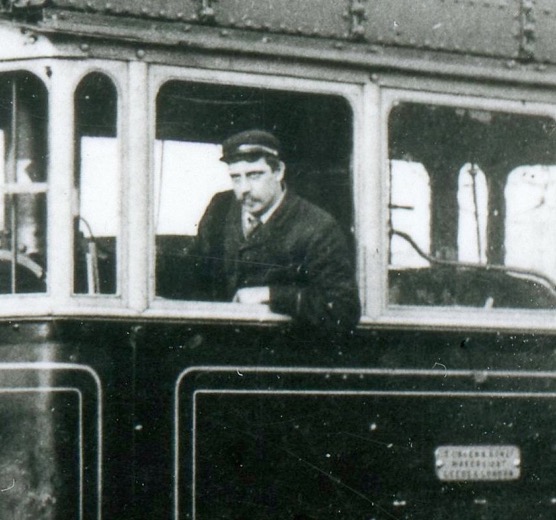
A blow-up of the above photo showing the driver, who is wearing a single-breasted, heavy-duty jacket and a soft-topped cap, all without insignia of any kind.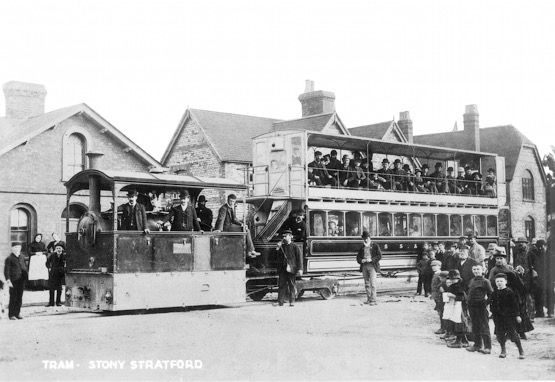
A shot taken outside the Foresters Arms in Stony Stratford — a location which was seemingly a photographers' favourite — with one of the unusual Krauss engines, and what would appear to be a brand new 80-seat trailer, dating the photograph to 1888. Photo courtesy of David Gladwin, with thanks to Trevor Preece.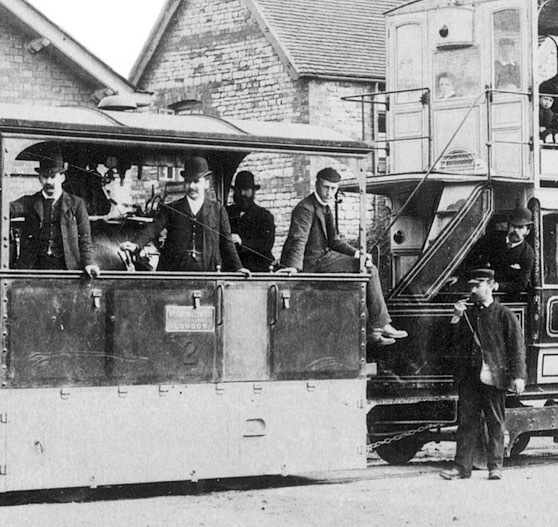
A blow-up of the above photo showing the driver (third from left, presumably) and the conductor (standing, whistle in hand). The driver is wearing an informal jacket and tall bowler with upturned brim (popular in the 1880s), with the conductor, also in informal attire, in a soft-topped, peaked cap, all seemingly devoid of insignia.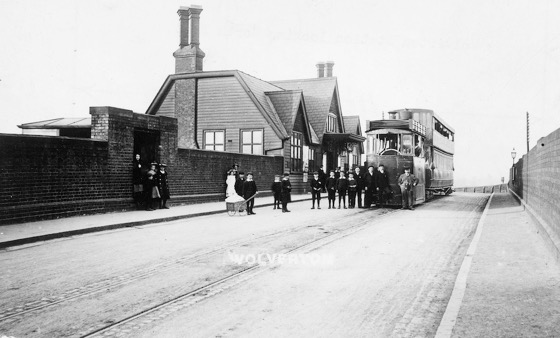
One of the Thomas Green & Sons engines stands with its long, sagging trailer outside Wolverton Station — photo undated, but from the fashions on display, probably taken in the late 1890s or early 1900s. Photo courtesy of David Gladwin, with thanks to Trevor Preece.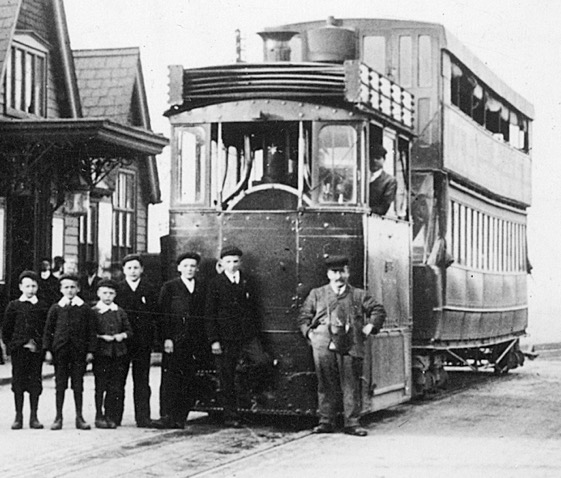
A blow-up of the above photo showing the assembled throng, including a conductor, in informal attire with a cash bag and soft-topped cap.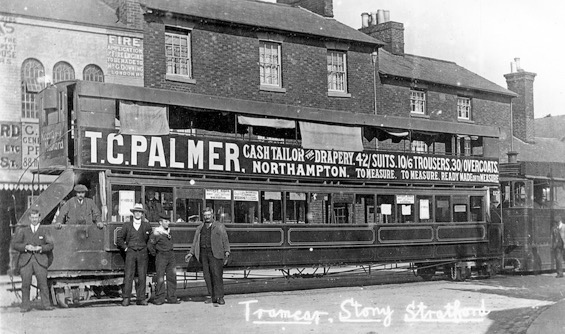
One of the extremely large 100-seater trailers stands outside the Foresters Arms in Stony Stratford along with one of the Green's engines — photo undated, but probably taken between 1910 and the Great War. Photo courtesy of David Gladwin, with thanks to Trevor Preece.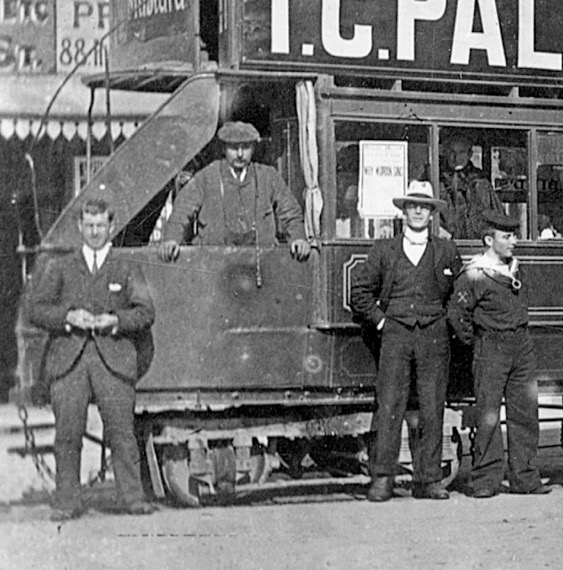
A blow-up of the above photo showing the conductor, standing on the rear platform with cash bag; he is wearing an informal jacket and a large flat cap.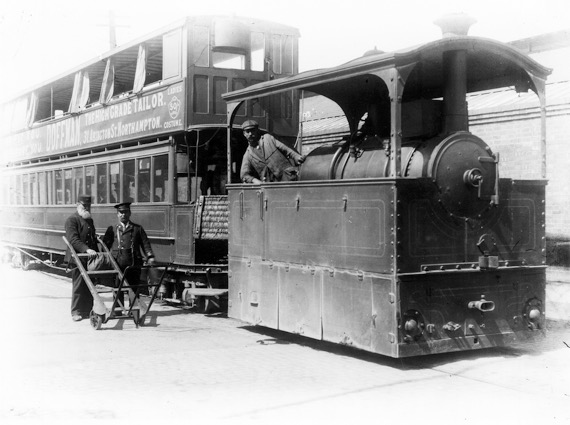
Steam Tram No 3 (a Krauss product) stands at Wolverton Station with one of the 100-seater trailers. The photo is unfortunately difficult to date. The advertisements on the trailer however, suggest that it may be Edwardian (or up to the Great War), yet no other photo from this period shows a conductor wearing a uniform. Photo courtesy of David Gladwin, with thanks to Trevor Preece.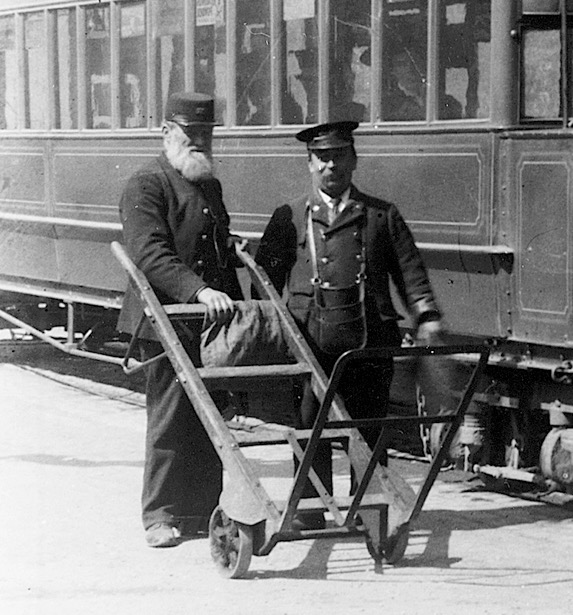
A blow-up of the above photo. The man on the left is definitely a postal worker, whilst the diminutive figure on the right is 'Little' Billy Newton, a long-time W&SS conductor; 'Little Billy' is clearly wearing a uniform and military-style cap, but seemingly without insignia of any kind.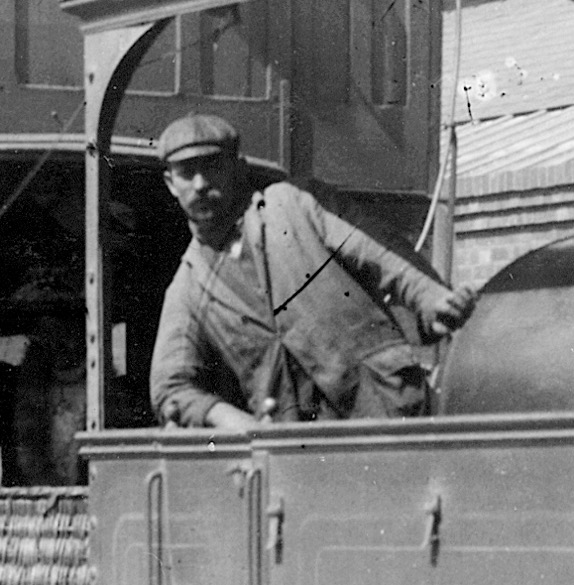
Another blow-up of the above photo, this time showing the driver, who is wearing a heavy-duty cotton jacket and a flat cap.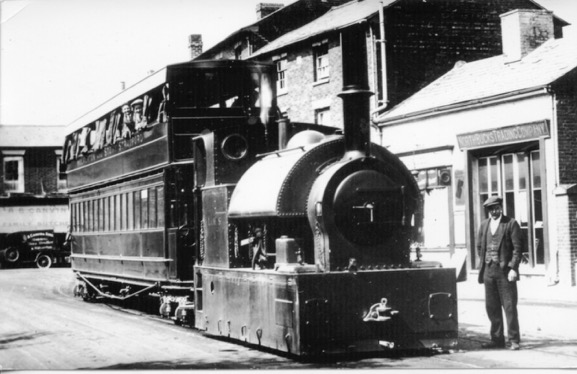
A well-known shot of Engine No 5 (a Bagnall delivered in 1921) standing outside the Forresters Arms — although undated, the engine is in LMS livery so it must have been taken after the railway 'grouping' of 1923. The man standing to the right may be the driver, though this is far from clear.